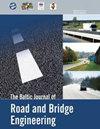道路安全地带露天排水地表水导水性评价
IF 1.1
4区 工程技术
Q4 ENGINEERING, CIVIL
引用次数: 2
摘要
随着排水系统数量的增加,从排水区清除地表水的研究的相关性也在增加。大部分地表水进水口安装在道路安全区的沟渠中,和/或安全区内流动地表水积聚的地形落差中。立陶宛修建和重建道路的实践表明,路段的每条新路线最频繁地穿过排水区,并重新分配该路段的径流特征。每个通过地表水水道的路基都是地表径流的局部堤坝。必须排放道路安全区内积聚的地表水,以避免道路结构受损以及排水路边区域的洪水。文章讨论了矿区地表水进水口等水利技术措施的效率,并强调了在对地表水进水口-排水线的完整排水系统进行综合评估时,水力计算的特殊性。本文还提出了一种用于系统进水-排水管线水力计算的方法。本文考察了具有F-5或PN-42结构的进水口的状况。2017年进行的研究结果表明,只有15.3%的地表水入口完全清洁,45.2%的入口被完全污染,39.5%的入口部分淤积。因此,观察到明显的向上趋势是用土壤和草根植物污染地表水入口的横截面积,而强烈的向下趋势是向干净的地表水入口横截面积。22.6%的地表水入口被农民使用耕作机械损坏。本文章由计算机程序翻译,如有差异,请以英文原文为准。
Assessing the Hydraulic Conductivity of Open Drainage for Surface Water in Road Safety Zones
The relevance of research on removing surface water from the drained areas has increased along with a rising number of drainage systems. A large part of inlets for surface water are installed in the ditches of road safety zones and / or terrain drops in safety zones where flowing surface water accumulates. The practice of constructing and rebuilding roads in Lithuania shows that each new route of the road section most frequently passes through the drained area and redistributes runoff characteristics of that sector. Each subgrade passing through the watercourse of surface water is a local dam for surface runoff. The surface water that has accumulated in road safety zones have to be drained to avoid damage to road structures and from the flood in the drained roadside areas. The article discusses the efficiency of hydro technical measures such as inlets for surface water in the mining area and highlights the specificities of hydraulic calculations when the complete drainage system for surface water Inlet–Water Drainage Line is integrally assessed. The paper also proposes a methodology for the hydraulic calculations of the system Inlet–Water Drainage Line . The article examines the condition of water inlets having the F-5 or PN-42 structure. The findings of the research carried out in 2017 demonstrate that only 15.3% of inlets for surface water were completely clean, 45.2% of the inlets were found fully contaminated and 39.5% of those were partially silted up. Thus, a clear upward trend towards polluting the cross-sectional areas of inlets for surface water with soil and grass root plants and a strong downward trend towards clean cross-sectional areas of inlets for surface water are observed. 22.6% of inlets for surface water were found damaged by farmers using tillage machinery.
求助全文
通过发布文献求助,成功后即可免费获取论文全文。
去求助
来源期刊
CiteScore
2.10
自引率
9.10%
发文量
25
审稿时长
>12 weeks
期刊介绍:
THE JOURNAL IS DESIGNED FOR PUBLISHING PAPERS CONCERNING THE FOLLOWING AREAS OF RESEARCH:
road and bridge research and design,
road construction materials and technologies,
bridge construction materials and technologies,
road and bridge repair,
road and bridge maintenance,
traffic safety,
road and bridge information technologies,
environmental issues,
road climatology,
low-volume roads,
normative documentation,
quality management and assurance,
road infrastructure and its assessment,
asset management,
road and bridge construction financing,
specialist pre-service and in-service training;

 求助内容:
求助内容: 应助结果提醒方式:
应助结果提醒方式:


